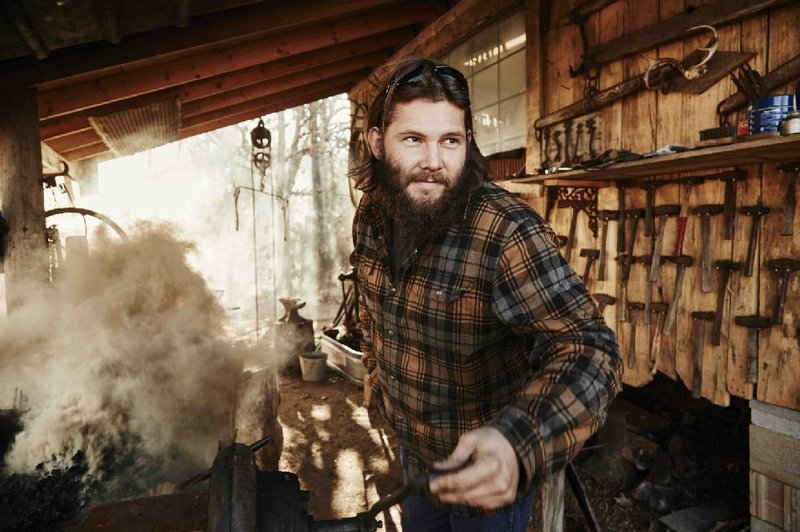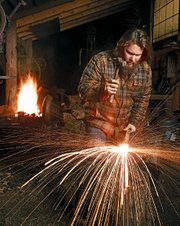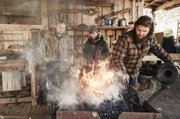At 28, blacksmith Daniel Casey of Romance is red-hot right now, thanks to his new History Channel series Iron & Fire.
But he was hot already, working as a craftsman of knives and firearms for more than a decade.
The Beebe native, home-schooled by parents Janie and Joe Casey (who still live there), built his first forge and started making knives when he was 12. By the time he was about 16, he began spending his summers apprenticed to world-renowned knife maker and gunsmith Hershel House of Woodbury, Ky.
"This has just been a blessing from God," Casey says of the show. "Matt Ayres of Half-Yard Productions was here in Arkansas speaking with other craftsmen who live in the Ozarks in early 2015, and my name came up." (A feature about Casey had earlier appeared in the Three Rivers Edition of the Arkansas Democrat-Gazette.)
"At the time we were renting a place in Center Hill and I was working there," Casey says. "He left me a message, I listened to it and called him back, and one thing led to another."
The show follows Casey as he fills customers' orders and creates a variety of weapons, including customized items such as a shotgun made with locally harvested walnut (from a tree that was felled in Center Hill by a tornado). He also makes replicas; he has copied a 200-year-old "Poor Boy" rifle; one of the very first Bowie knives ever made and made here in Arkansas; an 18th-century North Carolina-style rifle for a professional shooter; a Damascus steel blade dagger; and a short-range "smooth bore" shotgun, which was earlier used by soldiers in the Revolutionary, French and Indian wars.
To date, six episodes have aired, the first one April 11. New episodes air at 9 p.m. Monday. The most recent one showed Casey creating an American Indian tool, a pipe tomahawk. Meanwhile, History is also showing reruns of previously aired episodes.
The show's second episode, which followed Casey as he replicated an early Bowie knife made by James Black, featured a trip to the Historic Arkansas Museum in Little Rock and a visit with its longtime director, Bill Worthen. For Casey, it was also a bit of a homecoming.
"Daniel had worked here years ago when he was in his late teens, doing some blacksmithing as a demonstrator," Worthen says.
"His project [in that episode] was to take one of our very early Bowie knives -- Bowie Knife No. 1 -- and reproduce it," he says. "He wanted me to be the arbitrator of his reproduction, so I took it out of the case and he did all the measuring."
Worthen adds that the knife is considered to be one of the most important Bowie knives created.
A couple of weeks later, Casey brought in a copy of Bowie No. 1 to show Worthen.
"It's not an absolute copy but he made a very good knife," he says, adding that Casey used copper as the precious metal instead of the silver that James Black used on the original. "He wanted to distinguish the two from one another, but I thought he did a very good job."
Those crafting guns and knives have to use base metals, fine metals like silver, and wood, and put it all together in a way so the knife functions as one unit, Worthen explains.
"He's a fine young man and his skills have definitely blossomed."
Casey says the episode featuring the Bowie knife was one of a dozen he has filmed for Iron & Fire to date, and he doesn't know whether all 12 will air or whether the show will be renewed for a second season. "They have complete control over what they decide they want to do with it," he says. "I was just honored to be able to be a part of it at all."
CRAFTING A SERIES
Filming for the show began in late summer and early fall.
"It's all such a blur now," Casey says of the process. "We did a sizzle reel and then a pilot and then approached the network -- which then decided whether they wanted to do a one-time special or several episodes -- and then came to an agreement." (A sizzle reel is a brief, fast-paced, stylized video used to help sell a show to a network or to advertisers.)
Each episode took about a week to film.
"If we were building a rifle for a project, I would usually spend a week or two weeks of prep time getting ready for the rifle build, getting everything in place, and then we would usually spend a week building the rifle."
The crew worked six days a week for an average of eight to 12 hours a day, some days even longer.
"But we always had Sundays and Wednesday evenings off so we could go to church," Casey says.
BUSINESS IS BOOMING
"As far as ratings go, I don't believe we're at liberty to disclose that at this time," he says. "But we've had a lot of positive response locally and as far as our website and Facebook page and Instagram [caseyxarms], the response has been overwhelmingly positive, and we have more orders than we've ever had before."
In addition to information about his business, his site caseyarms.com also offers caps, T-shirts and hoodie sweatshirts bearing his company's logo with prices ranging from $15 to $45.
As for knife and gun orders, Casey says his business is back-ordered about a year out.
"One thing we refuse to ever become is a mass production business, and being what we are, it's all handcrafted with pride in the U.S., and we demand quality. If it's not quality, we absolutely will not ship it out," he says. In that "we" he includes his nephew Jonathan Kulik and younger brother Charlie Casey, who also appear on the show. Both have worked with him off and on through the years but are currently working with him full time.
The items they make are crafted traditionally. The only modern tools he and those working with him use are a hand drill, a bench grinder and a band saw.
"They are learning very fast," Casey says. "They handle the simpler knife orders, and I do all of the custom and gun orders. That's why we're so back-ordered; I can only stretch myself so thin."
When it comes to prices, the gun and knife maker declines to set a price range, but the custom order form on his website conveys that he doesn't make firearms for less than $2,500. The form asks customers to describe how much they are willing to spend, beginning with a range of $400-$1,000 and ending with $10,000 or more.
"Rifles and pistols from 1770s to 1830s is pretty much our forte," Casey says, adding that he reproduces cutlery from any time period.
"Since the show has aired, a lot of the people who've ordered rifles have wanted something that's one of a kind, to pass down," he says. "Not all are hunters or collectors; they see it as something that's very unique, one of a kind and Americana that they could pass down in their families -- which thrills me."
FORGING A FAMILY
Today, Casey is living his dream, working from his rustic wooden workshop next to the hilltop home he shares with wife Chelsey, 4-year-old son Wesley and newborn son Elisha, who arrived April 24, shortly after Iron & Fire premiered.
"He's a little unsure about it all right now," he says of Wesley's reaction to his new brother. "I think he sees a little competition in the future," he adds, chuckling.
Thanks to the attention the show has brought to his craft, Casey feels secure in his ability to provide for his growing family as a self-employed artisan.
"Many people who choose to do what I do and follow their dream of being an artist have a very insecure future because you never know what the economy or the future holds. But I feel like this show has given us a more secure future and faith that things will be just fine and we will be able to continue doing what we love -- turning out quality, one-of-a-kind items people can pass down from generation to generation."
OTHER IRONS IN THE FIRE
When he was interviewed by Three Rivers in late 2014, Casey said he was working part time as a machinist and dreamed of one day, possibly, making props for movies as did Frank House, the younger brother of Hershel House, with whom he'd apprenticed.
"But now with a family that's growing, I love being close to home, and we've got chickens and turkeys and hounds. I'm really happy with how things are going," Casey says. "I get to walk out and fill the order I choose to fill that day and stay close to home, the garden and the beehives. I feel very blessed to get to stay close to home.
"Working on props, you usually have to travel to the set to work. I'm not saying that if it fell into my lap, I would say no, but it would all depend on the situation."
What about working as a machinist?
"That's pretty much history now," Casey says, chuckling.
ActiveStyle on 05/02/2016



